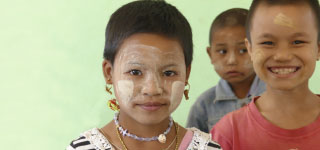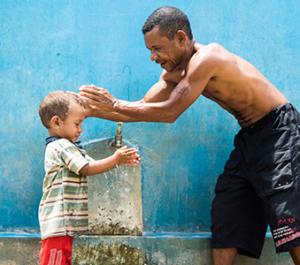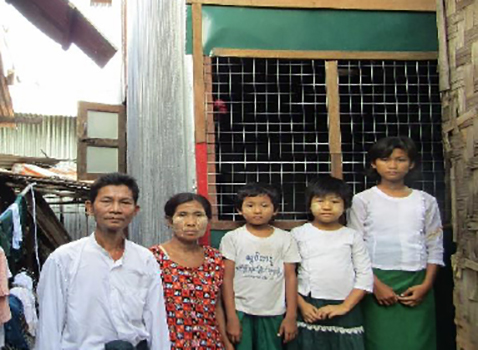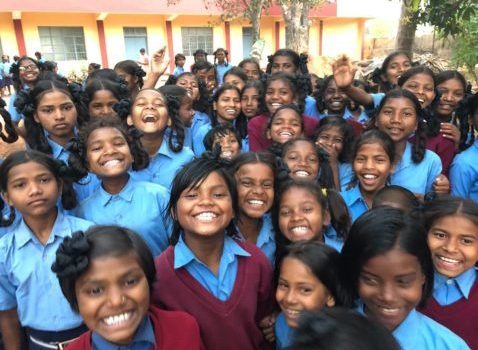Michael Finnane’s Experiences in Sri Lanka
MY FIRST TRIP TO SRI LANKA
SRI LANKA ( CEYLON) IN THE 19TH CENTURY
The Tamil Tea Pickers
The English set up large numbers of tea plantations in the 1840’s but found that the Sinhalese population would not work on the plantations. They were farmers and not labourers.
What the English did was to bring in from India, from what is now the Indian State of Tamil Nadu, large numbers of low caste Tamil workers to work as the labourers. These men and women were brought in as indentured labourers, with promises of housing and work. When they arrived in Colombo, no transport was provided, and they had to walk all the way up into the mountains until they got to the plantations to which they were assigned. There they stayed, living in deplorable conditions, trapped on the tea estates since they could speak no language but Tamil and thus could not communicate with the Sinhalese people living in the island. Most of them were illiterate, had no birth certificates and nothing to identify who they were. None of the Sinhalese people who lived in Sri Lanka were consulted about this, nor were the Tamils in the north and east of the country.
A Short History
The island of Sri Lanka is a small country with a number of different racial groups. The majority population is Sinhalese, who may have come into the island from somewhere in North India about 4000 years ago. Originally Hindu, an ancient ruler adopted Buddhism in lieu of Hinduism and it became the religion of the Sinhalese.
However, the northern tip of Sri Lanka is only about 80 nautical miles from the southern tip of India and, at least 2000 years ago, Tamil people started to come into the north and east of the country. These Tamil people were well established when the British arrived in about 1815.
By 1815, the Sinhalese kings had been forced back by Tamil incursions into Sri Lanka, into the hilly areas near Kandy and parts of the country to the south. The Tamils were in control of the north and east of the country. These Tamils were people of all sorts of caste and were predominately Hindu, although some had converted to Christianity. Two other large communities also existed in Sri Lanka – the Muslims and the Burghers.
Muslim traders of largely Arabic background started to trade with Sri Lanka probably about 1000 AD. They came from Tamil Nadu and spoke Tamil as their mother tongue. Many of them became settlers on the west coast of the country, intermarried with local women and became part of the general population.
In the north of the country, many Muslims also settled and became largely farmers. In the 19th Century, the British brought in from Malaya, rubber workers who also were Muslim.
The Burghers were mixed race descendants of Sinhalese or Tamil mothers and Dutch, Portuguese or English fathers. All of them were Christian, the majority being Catholic and over centuries from the 1500s, they developed a quite separate culture.
One of the tragic features of Sri Lanka was that the Tamils in the tea plantations were not regarded by the British as being worth anything much and no attempt was made to give them any standing in the country. They were labourers on tea estates, being paid a pittance for what they did and for a long time getting no education or health care. None of them had anything to do with the Tamils from the North and East of the country and it is probable that most of them did not know of the existence of Tamils elsewhere in the Island. Most of them had no contact with the majority Sinhalese population living around the tea estates.
Sri Lanka gained independence from the British in 1947. In 1958, the majority Sinhalese government removed citizenship from all of the tea workers, leaving them as the largest stateless population in the world, something over 1 million.
THE WORLD DEVELOPMENT TEA CO-OPERATIVE
In 1982, the World Development Tea Co-operative imported tea from Sri Lanka to promote Fair Trade and to improve the lot of the tea pickers. One of our posters said:
“There’s a fortune in your tea cup, but who gets it World Development Tea Co-operative . Quality Ceylon Tea- Justice in the tea trade”
So, we campaigned in Australia to raise the issue of Fair Trade and to get the tea pickers citizenship.
What we did not know in 1982, was that the Government of Sri Lanka had also made Sinhala the official language of the country. This created anger in the Tamil speaking north and east of the country and led to the formation of the Tamil Tigers, a terrorist group, whose aim was to get a separate country within the island for Tamils. By 1982, there had been many conflicts between Tamils and the Sinhalese, but no war as such. The Tamil tea workers were not involved in any of these conflicts.
In 1981, some Sinhalese parents of boys at St Patrick’s College at Strathfield, put a false story to the Government in Sri Lanka that the Tea Co-Op was giving funds to the Tamil Tigers and the Government stopped exports of tea to us. This led to me going to Sri Lanka with two other men to try and persuade the Government that we had nothing to do with the Tamil Tigers.
Sri Lanka, to most Australians, was an exotic country that we had known as Ceylon. Most of us drank Ceylon tea, but we knew little about Ceylon. Many of us did not know that Ceylon was a British name for Sri Lanka.
In 1982, there were elephants working on building sites in Colombo, hardly any cars, no sign of soldiers or armed police and it was apparently quiet, slow and peaceful.
None of us knew very much about the Tamil Tigers but I was able to persuade government officials with whom I negotiated that we sent no money to them nor to Satyodaya.
I spoke particularly to a Deputy Under Secretary of a Government Department who asked me who we were seeking to help. When I told him we were trying to help tea pickers, he said to me: “There’s no need to help these fellows, they get better pay than the people in the villages. Why help them?” This rather shocked me. He was, of course, a Sinhalese, but I had not expected someone in a senior public service position to be hostile to tea pickers.
When we arrived at Satyodaya, there was a drought in Kandy and a great shortage of water. I recall stone jars with porous stone filters in them for drinking water. Toilets at the back of Satyodaya were restricted in their usage.
At that time, I met Father Paul Caspersz and he and I struck up a friendship that has lasted until he died in 2017.
What struck me with force was that Satyodaya had working in it, Tamils, Sinhalese, Muslims and Burghers. Before I came to Sri Lanka I really did not know the difference between these groups but Father Caspersz and his staff made me aware of the differences. He told me how a most important part of their work was trying to bring these tea pickers from a state of semi-slavery to be able to live as ordinary human beings, to get an education and to be accepted into the community.
Through Father Caspersz, I became aware that there was a considerable difference between the Tamil tea pickers and Tamils living in other parts of the Island. Although we were only there for a few days, he arranged for us to see some Tamil tea pickers living in line huts on a tea estate near Galaha. I was shocked to see people living in such grim conditions with no access to sanitation and very limited access to running water. The people themselves were very small and very thin.
Fr Caspersz told me that Bishop Leo had asked him to become involved in setting up a centre to promote racial and religious harmony in Sri Lanka and to address the poverty of tea pickers and of Sinhalese villagers. From the time we first met, he would talk animatedly about these issues.
Fr Caspersz had been the headmaster of a leading Jesuit school in Sri Lanka and left it to work at Satyodaya, where he lived in quite basic accommodation. He was a graduate of Oxford and, in fact, was there at the same time as Cardinal George Pell.
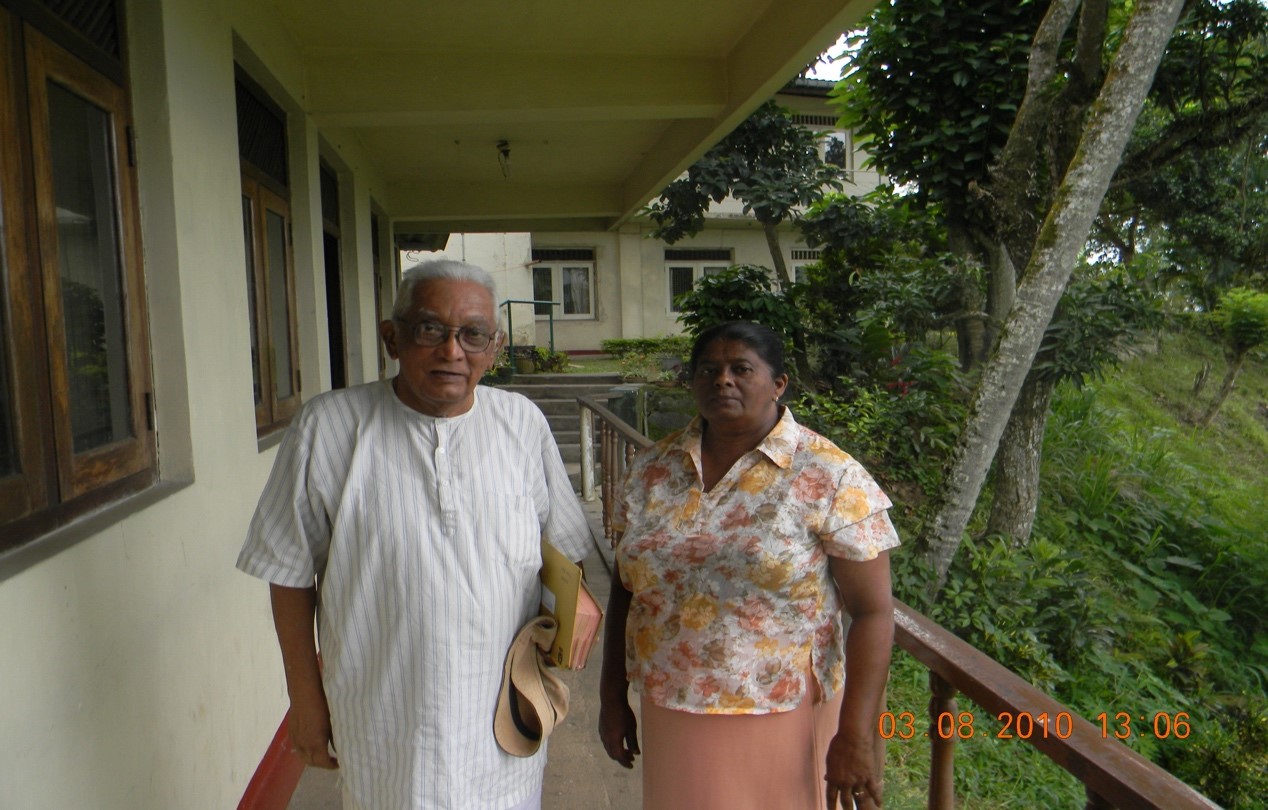
This is Fr Paul Caspersz S.J in 2010 with Noelene his long time helper and the cook at Satyodaya. He is standing on the veranda of what is now the Administrative Building.
Satyodaya was the first inter- racial, inter religious, community in Sri Lanka. Through Paul I met Sinhalese, Tamil and Muslim people all working together in harmony.
I came to Sri Lanka many times and always met Paul Caspersz. Usually we would meet in his room, near the old accommodation block and we would drink and chat. He drank the whisky I usually brought with me. I drank tea or water. We would talk about politics, religion, racism and many other topics.
Noelene would come and take us to dinner, which Paul shared in the dining room with all the staff and any visitors who might be there. On a Sunday, he would say Mass in a little room. Noelene and other Catholics would be present with me at Mass. Paul got people to take me to tea plantations and to meet village people. Through him, I met many people of all faiths and races.
Later, I came with my wife, Jill, and we stayed in a little room on a veranda at the back of the hall. On one of our visits, in 2001, Jill ran permaculture courses for Satyodaya and other communities and we taught English at Satyodaya. As well as this, we taught English to the Jesuit novices, the Anglican clergy at Kurunagela, workers at Hatton and village people and Muslims at a jungle school near Dembadeniya.
Over the years since, I have visited Satyodaya many times and through them I have visited many communities on tea plantations as well as many people living in Sinhalese villages.
What has to be understood about Sri Lanka is that it is a nation of villages. There are two cities. Colombo, the capital, with about a million people living there and Kandy, in the hills, with about 500,000 people but most of the 23 million people live in small villages dotted throughout the country. Most people are relatively poor, but to my observation, there is no evidence of starvation or even of beggars. The soil is fertile, rich and deep, the temperature, except high up in the mountains is warm and there is an abundance of food.
However, the various communities do not entirely get on and from time to time there is inter racial and inter religious violence.
There are about 1 million Catholics and slightly more Muslims in Sri Lanka. Until Easter 2019, there had never been violence between Catholics and Muslims. The Tamil Tigers persecuted the Muslims in the North and East, making many of them homeless. In other parts of the Island, some Buddhist extremists from time to time attacked Muslims and Christians as well.
When we arrived in 1982, everything seemed peaceful. Satyodaya had a number of quite large buildings, but no real accommodation for anyone but the Satyodaya workers. It had a hall where conferences were held and a dining room where all the staff ate.
At its height, Satyodaya probably had more than 30 people working on the premises, all of them looking to Paul Caspersz for inspiration and leadership.
In later years, I found it sad to see that the buildings at Satyodaya were crumbling and many of the organisations that used to sponsor the work of Satyodaya ceased to be involved. This happened, I think, because of the war against the Tamil Tigers. European NGOs became disillusioned with Sri Lanka and turned their attention to Africa. This caused Paul great sadness and was a factor in the decay of the buildings.
Ultimately, Fr Caspersz’s health declined to the point where he had to retire and go to live as an invalid, in the Jesuit house in Negombo. It was sad to see him there so far from Satyodaya, which he badly missed. He found it hard to accept that he could no longer be involved. Eventually, he could not sit up and could not care for himself at all. He still recognised Jill and me, but clearly he was gripped by a form of dementia. This was certainly very sad.
Paul Caspersz died in late April 2017. When he died at the Jesuit provincial house in Negombo, he was very sick and completely helpless. His carer was a Pakistani refugee living in Negombo.
The Jesuits did not abandon Satyodaya when Paul became ill. They sent Father Christian Perera S.J to keep it going and they authorised a building programme, that not only restored the buildings, but enabled the main building to be used as a hotel for paying guests. This provided significant revenue to Satyodaya and enabled it to continue its work, especially, but not exclusively in the tea plantations.
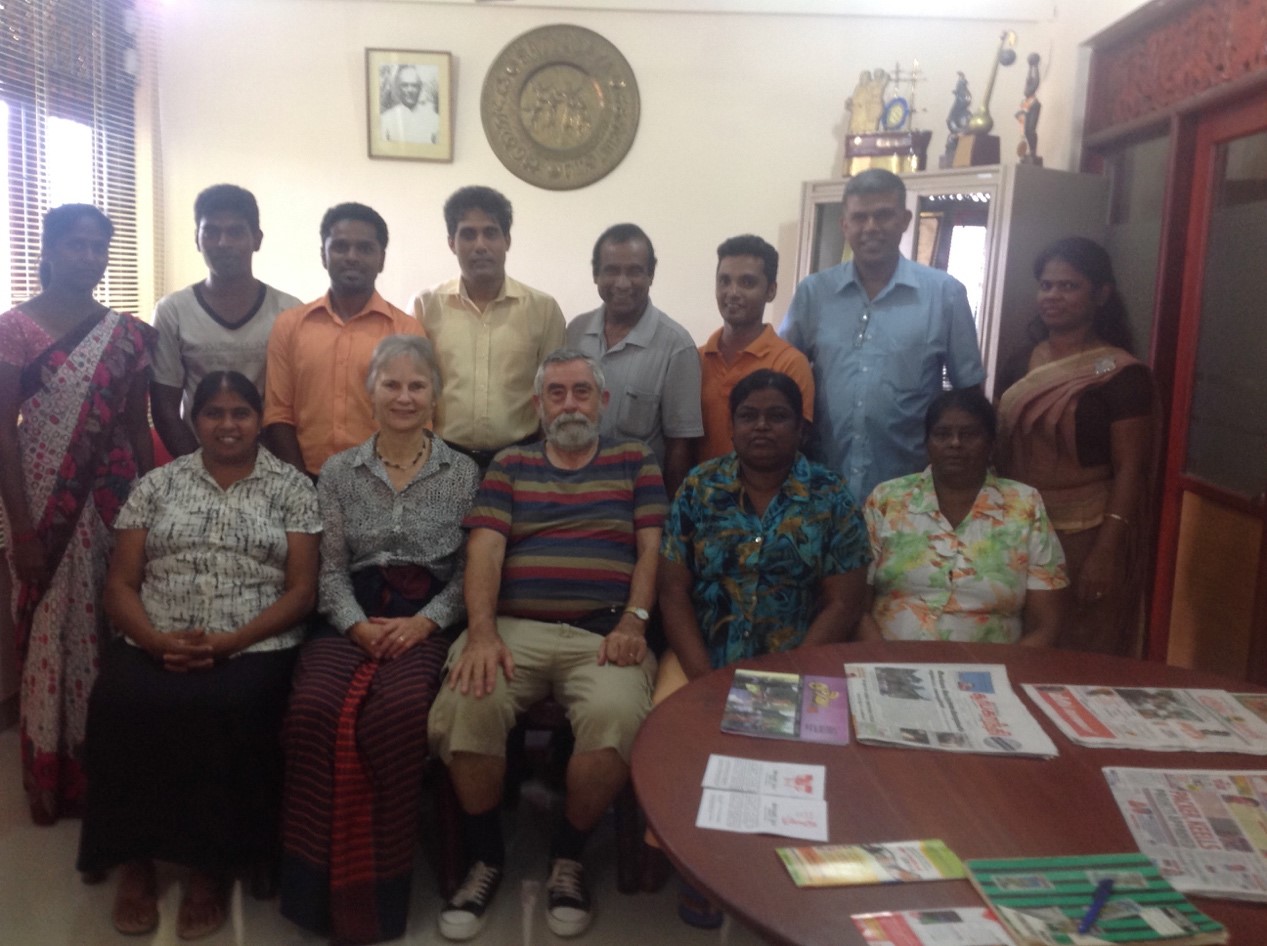
This photo shows Father Christian Perera, other staff member, Jill and I in 2014
Earlier this year, Fr Kamal Andradi S.J took over as the Director.
THE TRIP IN 2019
When we arrived in Sri Lanka, it was markedly different to the way it was in November last year. Last November, there were no soldiers on the street and the police were not armed. When we got into the airport, we immediately noticed armed police and armed soldiers. This was what it was like when the war against the Tigers was on before 2009.
It was difficult getting away from the airport because soldiers stopped every taxi as it arrived and check for weapons and bombs. Eventually, we got into the taxi and headed off for Colombo about half an hour away. The airport itself is actually quite close to Negombo, the place where the bombs went off on Easter Sunday.
The road to Colombo was almost empty, although there were soldiers and police at various points. We were stopped in Columbo by a group of armed police who made enquiries of our driver but did not speak to us. It was strange coming along into a large city that had no one on the street. Normally there would be people walking around, even late at night, coming home from restaurants and other places of entertainment. The only cars on the road were taxis.
We stayed at the home of a friend and next day set out for Kandy. Traffic was very light along the way, which was most unusual and when we arrived in Kandy, we met father Karl Andradi SJ, the new director of Satyodaya ,and all the staff. There was an air of gloom, because they were not allowed to take us up to the tea plantations. All gatherings were banned, and this meant, as well as our being prohibited from going to the tea plantations, that a certificate ceremony where I would present certificates to young men and women who had passed a leadership course conducted by Satyodaya could not be held.
One of the reasons for our trip was to show Jamie and Simone, my son and daughter-in-law, what life was like on the tea plantations. The intention was to go to one of the projects being run by Satyodaya, where education was emphasised, and considerable help had been given to raise the living standards of the workers. It was a great disappointment that we could not go. Instead, we took a car to Nuwara Eliya, a beautiful town high up in the mountains.
On the way to Nuwara Eliya, we passed numerous tea estates but there was not one person working on them. In all the years I have been going to Sri Lanka, I have never encountered completely empty tea fields. Again, this was disappointing as I could not demonstrate to Jamie and Simone what the tea pickers did. There were few people on the road, although there may have been 10 or 20 at a cafe that we stopped at halfway up.
Nuwara Eliya is also known to the locals as little England because it was used by the British in summertime as a retreat from the heat in Colombo and because they built houses with mock Tudor facings. Many of the buildings are distinctly English, and it is cool and pleasant. Now it has become a large agricultural area where a great deal of vegetable growing occurs. There is a large lake and pleasant restaurants are evident.
Normally, in April, there would be many people present at Nuwara Eliya because it is the hottest month of the year and many people choose to go to this town because of its cool climate. From the point of view of the local people, I think it would have been quite disastrous that there were so few tourists. There might've been 20 or 30 European-looking people in a town where at this time, many hundreds could have been expected.
Kandy itself was not completely empty, but certainly there were few foreign faces. At Satyodaya, there were a group of about 30 people from the Czech Republic, but they were going within a day or so. Because we could not go to any of the projects, we only stayed two days. Jamie and Simone visited the Temple of the Tooth, a beautiful and ancient building which is believed to house a tooth of the Buddha. For anyone going to Sri Lanka, a visit to this temple is a must.
Satyodaya is set up on a hill and has a magnificent view right across Kandy. There are many rooms in its hotel, all of which are comfortable, have their own bathrooms and, of course, free Wi-Fi. All the guests have breakfast, usually on a veranda overlooking the town. It really is most beautiful.
It is possible to walk down the hill, and certainly I have done it frequently. Many guests use the tri-shaws, which are very common in Sri Lanka. While we were there, we certainly met other European-looking people, but the large tour groups were not present. As we understood it, all of them started leaving the country on the day that we arrived.
Satyodaya depends almost entirely on revenue from its hotel. Certainly, it does get donations, but these are not enough to keep it going. Father Karl and all his staff were gloomy and quite apprehensive.
The government put curfews on each night but after the first night people could move around till 10 pm. All social media was blocked to prevent troublemakers spreading rumours. While we were there, the government allowed social media to operate again. This is thought to have been the cause of the trouble in the Northwest province because of false rumours being spread on social media about Muslim insurgents. The result was that quite a large number of peaceful and innocent Muslims were attacked and seriously injured.
Cardinal Ranjith appeared with leading Muslim community leaders, begging for peace and tolerance. He publicly declined the offer of a bullet-proof car, saying that the government should provide security for all the people and not just people it considered to be important. I was most impressed by his leadership.
When we left Kandy and returned to Colombo, it was again noticeable that there was very little traffic and few people were on the street. I stayed in Colombo for three or four days, while Jamie and Simone went to the south to a seaside area known as Hikkaduwa. They looked round there as well as at the Galle Fort, an ancient Dutch built fort.
Colombo was again very quiet. My friend and I went to a number of restaurants, but on each occasion we were the only ones there. Three hotels in Colombo were bombed, and I had been to each one of them at various times. I could not see the connection between St Sebastian's Church in Negombo, St Anthony's Church in Colombo and these three hotels. A Protestant church on the other side of the island was also bombed. Again, it was not clear to me why a Protestant church on the other side of the island should be bombed.
Another puzzling feature of all of this, was that the organiser of the bombing was himself killed in one of these bombings. Muslims are only 7% of the population and they have never shown in the past any interest in supporting the activities of terrorists in the Middle East or anywhere else. Their community has always been peaceful and has never been a threat to anyone else at all.
My friend in Colombo is a leading Muslim businessman. He is appalled by what has occurred, and completely fails to understand what lies behind it. It became obvious while we were there, that many members of the Muslim community had tried, for a number of years, to alert politicians and the police to the dangerous attitudes of the people who became involved in the bombing, but no one took any notice.
The Indian police had given the Sri Lankan police information about these bombers a long time before these incidents occurred, but according to the president and the prime minister, this information was not passed on. I found this hard to believe, but there has, undoubtedly, been considerable problems within the government for some time. Last November the president attempted to dismiss the Prime Minister and his government, even though they held a clear majority in the parliament. Eventually, the Supreme Court decided that the government could not be dismissed in this fashion and the president had to back down. It may be, that because of this tension, the information about the bombings just did not get through. Perhaps one day we will learn.
We left on 1 May 2019 at night-time and had to allow 3 to 4 hours to get into the airport. This was because the security at the airport was so intense that people were finding it hard to get in. When we got into the airport, we discovered that the plane we had booked on was overbooked and it took a lot of talking to be able to stay on that plane.
As we were coming back on the plane, I found myself seated next to a man who, like me, was a Catholic. He had come originally from Sri Lanka and was back to see some relatives. The hotel he was in on the night before Easter Sunday, was booked out by local people who were attending church in Negombo. As he explained to me, Negombo is the start of a long ribbon of Catholic habitation in Sri Lanka. Just about everyone in Negombo is a Catholic and there are a number of Catholic churches in the area, as well as the Jesuit provincial house and other similar institutions. St Sebastian's Church, although a large one, is not the only church in the area and many people were at other churches, fortunately for them. As my companion explained to me, as soon as the bombing happened, the hotel he was in emptied, and the local people who were there fled back to their homes.
In Colombo, St Anthony's Church was bombed. It is a church attended by people of all faiths and cultures because of a popular belief that Saint Anthony can bring them good luck. It is quite likely that people other than Catholics were killed or injured in the St Anthony's Church bombing.
The consequences of these terrible acts are devastating for Sri Lanka. Tourism is a major source of income and probably now exceeds the income the country gets from selling tea. Many hotels have been built since the Civil War ended in 2009 and many of them are now largely empty. What will happen to all the staff of these many hotels?
Tourism may well return, as it has in Bali, but the damage to the country is quite extreme. Sri Lanka, because of the Civil War, has become very poor. An Australian dollar is worth Rs.119. The tea picker gets Rs.1000 a day, something like eight dollars Australian. When I first went to Sri Lanka in 1982, an Australian dollar was worth Rs.20.
Staying in Sri Lanka is cheap. A night at Satyodaya costs about $20 Australian, and it is possible to stay at hotels all around the country for little more than that. Of course, the major hotels in Colombo are more expensive, but not nearly as expensive as hotels in Europe and Australia. Many people come to the country from Germany, Austria, Russia and England, particularly in the northern winter, to have a cheap holiday by the beach ,in a warm place where many people speak English.
I have always enjoyed going to Sri Lanka and I have never felt threatened, even in the time of the Civil War, but these bombings left me perplexed, because they do not appear to be directed at any particular purpose.

Michael Finnane QC
3 June 2019

